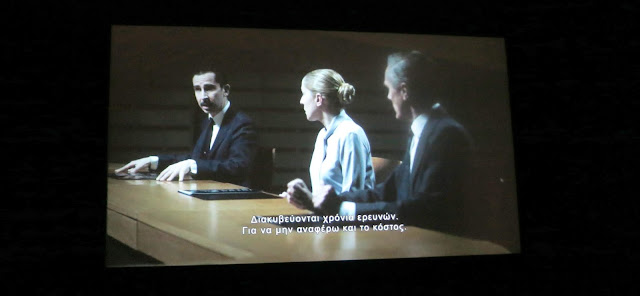This thought-provoking narrative video installation was the Greek entry at the Venice Biennale. We were very lucky to be able to explore this as the issues that it raises have a contemporary resonance, but it was also great fun.
Based on Aeschylus' play Iketides (Suppliant Women) and the dilemma it poses, between saving the Outsider or maintaining the safety of the Native, it attempts to expose the confusion of individuals and social groups when called upon to address similar dilemmas. It's the first text that raises the issue of a persecuted group of people seeking asylum. The Suppliants have left Egypt to avoid having to marry their first cousins and arrive at Argos seeking asylum from the King of the city. The King is faced with a major dilemma. If he helps the foreign women, he risks inciting a war with the Egyptians who will come to take back the Suppliants. But, if he doesn't help them, he will be breaking the sacred laws of Hospitality, violating the principles of Law and Humanism, leaving the Suppliants to the mercy of their pursuers, who might destroy them.
Drivas presents the play's dilemmas through the excerpts of an unfinished documentary about a scientific experiment. For unknown reasons, this experiment was never completed. The excerpts from an old documentary reveal for the first time the details of the experiment, the hopes of the Greek professor who envisioned it, and the disagreements he has with his co-researchers. The project went through many stages. During the last stage, the researchers discovered a group of new cells in their cell culture, cells which were different from the ones being investigated. These new ones were vulnerable outside the cell culture and were showing attempts to organise with the old cells.
Should the researchers allow the two cell populations to integrate, in the hope that, through their interaction, the new cells would be able to survive and thus give the research group the opportunity to study and possibly improve the existing culture? Or should they prevent them from organising themselves, isolate and condemn the new cells to distinction, given that this new union could dangerously corrupt the existing culture?
We entered a very dark space and were directed to climb the dark stairs.
We arrived at a raised corridor. Along the bannister of the corridor there were

6 small screens showing the 6 excepts of the found footage, each of which runs for one to two minutes, on a loop.
Below we could see a dark labyrinth
We walked down the stairs and started exploring the labyrinth.
We watched 5 video excerpts from the documentary which consisted of discussions between the researchers in the lab at the moment they had discovered the problem with the new cells.
We then moved on to the screening room which was located at the end of the labyrinth. There, on a large screen, we watched a filmed representation of the last meeting of the team of researchers who discussed the ethical issues of the dilemma.
One member of the panel, reenacted by Charlotte Rampling, argued that the new cells need to be destroyed given that they might corrupt the existing culture. The original end of this conversation is unknown and so the reenactment stops at the most critical moment, restarting again from the beginning. The outcome remains open....








No comments:
Post a Comment